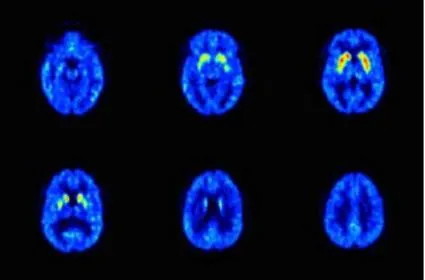
Serotonin h-HT4 receptors visualised in the living human brain using a carbon-11 (radioactive half-life 20.4 min) labelled receptor ligand. Note the high concentration of these receptors in the basal ganglia.
Non-invasive imaging of the central nervous system has been a major application of PET over the last 25 years. To date numerous 11C and 18F radiotracers have been developed and applied for basic, clinical and translational research into brain function in health and disease. These include radioligands for imaging numerous receptor and enzyme subtypes, labelled metabolic substrates, endogenous and exogenous compounds. Some Examples of 18F and 11C labelled compounds of interest are shown in the table below.
The Department has strong links to the institute of Psychiatry and many other CNS-related departments at King’s. Diseases of interest include Schizophrenia, Autism, Anxiety, Depression, Dementia, Epilepsy, blood-brain-barrier function (e.g. Drug efflux pumps) glia imaging and the evaluation of novel and established therapeutics.
|
Receptor Ligands
|
|
D1
|
SCH 23390, NNC 112
|
|
D2
|
Raclopride, NMSP
|
|
DAT
|
b-CIT and analogues
|
|
5-HT1A
|
WAY 100,635 and analogues
|
|
5-HT2A
|
MDL 100907
|
|
Muscarinic
|
NMPB, TRB
|
|
Nicotinic
|
Epibatidine and analogues
|
|
Opiate
|
Carfentanyl, Diprenorphine
|
|
Benzodiazepine
|
Flumazenil, RO-15 4513
|
|
|
|
Enzymes
|
|
MAO A
|
Harmine
|
|
MAO B
|
Deprenyl
|
|
VMAT
|
Tetrabenazine
|
|
PDE 4
|
Rolipram
|
|
AchE
|
Piperidinyl esters
|
|
|
|
Metabolism/haemodynamics
|
|
LMR Glucose:
|
FDG
|
|
Blood flow:
|
H20
|
|
Blood Volume:
|
CO
|
|
LMR O2:
|
O2
|
|
Hypoxia
|
FMISO
|
|
Amino acids:
|
Alanine, Methionone, FDOPA
|
|
|
|
Drugs of Abuse
|
|
Heroin
|
|
|
Cocaine
|
|
|
Methamphetamine
|
|